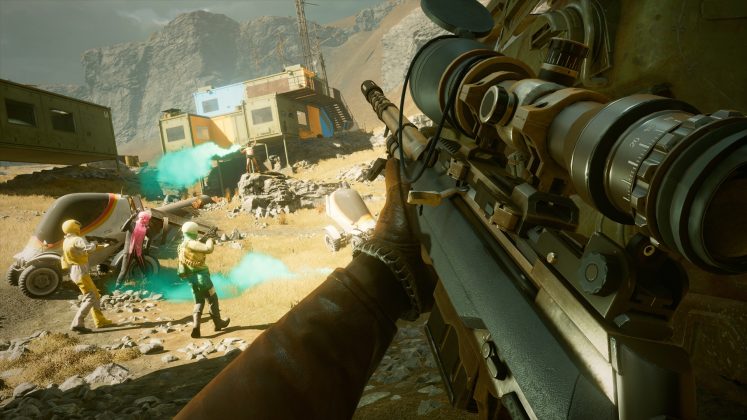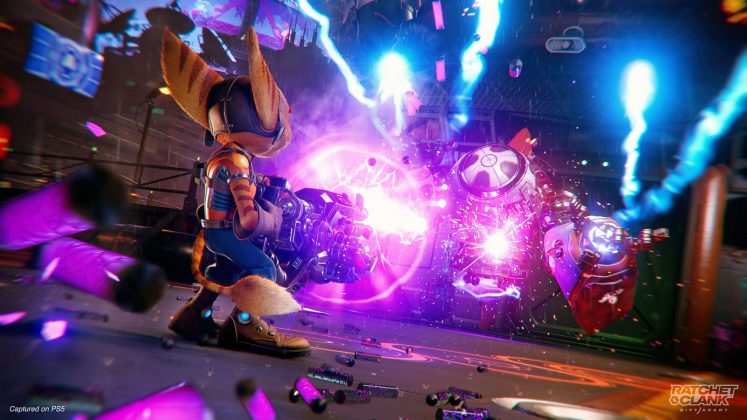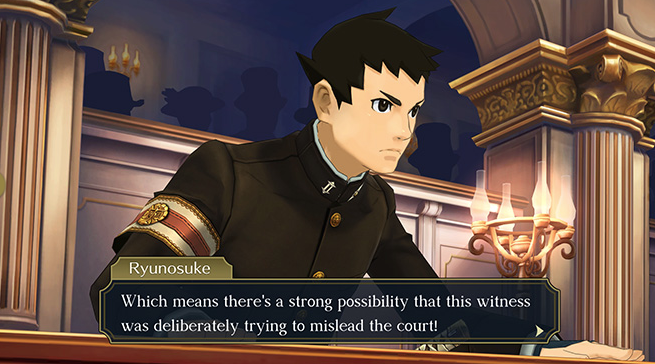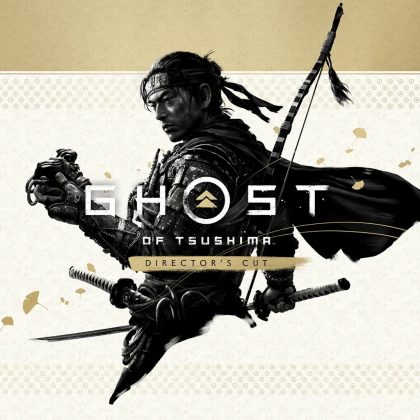Videogame Reviews
Deathloop
Sony PlayStation 5
Ghost of Tsushima Director’s Cut
PS5
Ratchet & Clank: Rift Apart
PS5
The Great Ace Attorney Chronicles
Nintendo Switch
ARKANE Studios and Bethesda Softworks have outdone themselves with Deathloop. Featuring a likeable protagonist, a flexible open map to explore, and a fast, fluid combat system, their latest offering brings to mind their earlier games in concept and mechanics — but presented better — make that much better — gameplay, style, and substance.
In Deathloop, you play as Colt Vahn, an amnesiac who finds himself stuck in the middle of the island of Blackreef with no clue as to what’s happening. Caught in his own personal version of Groundhog Day, Colt is hunted by the island’s residents, and a mysterious woman named Julianna who’s holding a grudge against time. Trapped in an infinite loop of repeating the same day, and urged on by a consciousness he doesn’t yet fully understand, Colt must somehow find a way to learn more about the island, and break the timeloop that has kept him trapped.
This means using Colt’s extensive skills in order to learn more about the island. Many opponents stand in his way, but while Colt may have forgotten his memories, his instincts are still sharp. He can skulk, dodge, leap, and shoot with the best of them, and he has to if he means to find a way to break the loop. Colt is clearly experienced in the use of weapons, and the various guns Deathloop gives are satisfying to use. These range from silenced pistols and magnums, to stronger submachine guns and shotguns, all of which are capable of downing enemies with a few well-placed shots.
On the flipside, Deathloop requires Colt to operate under similar conditions – which is to say he shares this similar downside of being brought down by a few well-placed shots by otherwise inaccurate enemies. This turns gunplay into a satisfying, if frantic, mess of bullets and positioning. And while the game is pretty forgiving, with plenty of ammunition and health stations (and fiz-pop bottles) lying around, going head-first with guns blazing just isn’t always the right way to solve your problems.
This is where the stealth elements of Deathloop comes to the fore. Taking from such notables in Arkane and Bethesda’s library as Prey and Dishonored, the game features a robust power system that helps you when you’re sneaking about, letting you unlock upgrades not just for your character and his weapons, but also active abilities that you can leverage for use. Features like Invisibility and Blink are all essential when going on a stealth run, and these give so much depth when exploring the map, letting you explore places you normally would have trouble reaching. Your reward for this isn’t just more ammo, but also more information, and you’ll slowly start to unlock more information about the island and understand the motivations of its denizens.
At first glance, Deathloop’s gameplay might seem hampered by the fact that there are only four unique locations to explore, but there’s a twist. Time passing slowly has an impact on what enemies you can face, what information you can glean, and even what side-quests you can take on. Certain events happen only during a certain time of the day, and, if you miss these, can change what happens later on in the same location. This means having to not only budget your time carefully, but also piece together the information you find, and even using what you know with what events you figure will happen.
This system is what allows Deathloop to present its story piecemeal, but without making the player feel lost. It’s like a detective story coming together. You’re slowly unravelling the relationships that keep the island stable, and carefully finding a way to leverage them to your advantage. While death may set you back, the information you gather in these runs is permanent and ingrained, and each little step you take is, in the final analysis, progress. In a lot of ways, it feels more like a rogue-like, where your advancement slowly ramps up as you learn more and more not just about the narrative, but about the events surrounding it.
It’s this unique gameplay loop that makes Deathloop really shine. Not many games can really incorporate a system like this fluidly. Deathloop does, and exquisitely, managing to keep it interesting with its constantly evolving world and its dynamic gameplay. From how new information and side-quests can warp your decisions, to how principal antagonist Julianna Blake’s ambushes can throw a monkey wrench into your plans, it’s a game that thrives on both repetition and flexibility, and it’s one that keeps itself entertaining from start to finish.
To be sure, Deathloop isn’t perfect. Gameplay bugs will, on occasion, creep up, with some of them highlighting shoddy enemy Artificial Intelligence. And then there are the random crashes that can soft-lock progress; one bug, for instance, kept happening in the same cutscene, only to solve itself after about an hour. Given the technical glitches, it’s just too bad the game doesn’t let you save mid-mission. The good news is that Arkane and Bethesda continue to improve on the product, issuing patches as necessary.
In any case, Deathloop is an outstanding release. Featuring all the best of the best of Arkane and Bethesda’s collaborative efforts, it’s an action-packed title that provides no small measure of introspection as well. Highly recommended.
THE GOOD:
Unique and engaging in its singular mix of stealth and gunplay with puzzle and adventure elements
Interesting twist of gameplay loop, requiring you to learn about your enemies and exploiting their weaknesses/quirks as you go through the same scenarios again and again
Strong, interesting, multi-layered characters
THE BAD:
Bugs show up on occasion
Some textures don’t render well
Sound can be a bit off at times
RATING: 9.5/10
POSTSCRIPT: Ghost of Tsushima was among the few Sony PlayStation 4-exclusive titles that had gamers in other platforms casting envious glances. Its concepts may not have been original or unique, but the fact didn’t really matter, because it was able to distinguish itself with its art style and its dedication to Japanese inspirations. While it took artistic liberties when portraying the Mongol Invasion of Japan, it was respectful to its source materials, and clearly inspired by the spectacle of Samurai Cinema. It emulated the works of directors like Akira Kurosawa, and excelled at delivering a gripping tale of loss and survival, of the constant interplay between pragmatism and idealism. It was an amazing experience, one that really pushed the limits of what the PS4 could do. And now, with the release of the Director’s Cut on the PS5, it’s back in all its glory, but bigger and better, ready to show us what tricks it can pull off with next-generation hardware while adding content to boot.
For those who lived under a rock in recent memory, a quick recap: Ghost of Tsushima has you play as samurai Jin Sakai in his desperate attempt to fight off the Mongol invaders. Using stealth, guile, and swordplay to conquer his foes, he sets out to liberate the oppressed people of Tsushima Island. It’s essentially Assassin’s Creed with a far more intense focus on Japanese culture. You’ll be exploring Japanese castles, traversing peaceful grasslands and forests, and fighting off wandering ronin and bandits — all while upgrading the strength of your sword and armor, and honing Jin’s samurai skills to prepare him for the inevitable showdown with the villainous Khotun Khan.
What this means is you’ll be going out of your way to scavenge supplies and take down enemy fortresses from within. Enemies in Ghost of Tsushima are surprisingly deadly and, on the game’s harder modes, quick as well. A momentary lapse in concentration with have you reloading from your last checkpoint, especially with how aggressive and plentiful enemies can be. You’ll have to parry, dodge, and cut your way through each encounter in the hope of staying alive.
Thankfully, Jin has many tricks up his sleeve to help him out. His sword skills are fantastic, allowing him to duel and defeat even the toughest of opponents. By taking down commanders, Jin’s own legend as the Ghost of Tsushima grows, and with it, his prowess in combat, allowing you to unlock useful skills and abilities. For example, being able to roll unlocks huge potential in how you take fights, and the game’s unlockable Ghost Weapons afford you even more flexibility in how you approach encounters. You can stun groups of opponents with your smoke bomb, or take them down with arrows. You can lure them out with a noise charm, or assassinate them from hidden positions. If you’re feeling honorable, you can even challenge them to a duel, using Iaido — enhanced awareness and capacity to act and react quickly — to cut them down one by one.
Ghost of Tsushima was a memorable experience on the PS4, and it’s even better on the PS5. The game, which already looked beautiful, looks even better on superior hardware. The experience is truly enhanced when it’’s running on a smooth, crisp 60 frames per second. The Director’s Cut also boasts additional content via the Iki Island expansion — a solid integral extension that colors Jin’s relationship with his family. Add that to the coop function that Ghost of Tsushima has through its Legends gameplay, and you have a solid single-player and multiplayer experience on the next-gen console. Whether alone or with friends, Ghost of Tsushima is prepared to entertain, and does so in style.
If there’s a negative (if it can even be called that) to Ghost of Tsushima Director’s Cut, it’s that the upgrade comes with a cost. However, owners of the game on the PS4 can avail of the Director’s Cut on the PS5 at an affordable price. And, really, with how much new content it offers as well as the chance to relive the old ones in higher definition, any price you can pay to experience it anew under better conditions is a steal.
Ghost of Tsushima was deemed groundbreaking upon its release last year, and it has aged well in its transition to the PS5. It’s simply better in every way, and a can’t-miss title for those who already own the platform.
THE GOOD:
Smoother, crisper gameplay and visuals, thanks to the enhanced engine
Additional content to keep you entertained
Excellent single-player and multiplayer options
THE BAD:
The upgrade comes at a cost
RATING: 9.5/10
Ratchet & Clank: Rift Apart on the PS5 is a special experience steeped in nostalgia and old-time gameplay. The iconic duo of Ratchet and Clank are back at it again to save the universe, providing gamers with an intoxicating, exciting adventure, focused on exploration, third-person gunplay, and first-rate platforming from start to finish.
Ratchet & Clank: Rift Apart makes sure to keep the classic formula of the franchise’s previous releases. You’re still traversing unique, colorful levels with your chosen character. You still have the game’s witty, interesting dialogue interspersed with wacky, entertaining combat segments. You still have heartwarming scenes mixed in with fast-paced platforming and racing, complete with mini-games and side objectives. In a lot ways, it’s what you expect a Ratchet and Clank game to be, but on overdrive — and, honestly, that’s what makes it so compelling.
Ratchet and Clank: Rift Apart is a solid experience because it does everything extremely well. Take for instance, its gunplay. It starts off simply, handing you simple weapons like a laser gun that acts as a pistol, or a scattergun that functions as a short-range shotgun. While not trend-setting, these are the backbones on which stronger, more interesting guns start to appear. Homing missile dogs that lock onto enemy targets and explode on contact, a Mega Man-style megabuster, and a zapgun that spreads lightning to enemies — these are but a few of the weapons you can lay your hands on, each one useable and unique in its own way.
Pair this up with Ratchet and Clank: Rift Apart’s intense platforming action, and you have what makes for some fun action set pieces. You’re constantly dodging and weaving to avoid enemy shots, using cover and dashing between their bullets to find your own timing to strike back, and with the vast array of weapons at your disposal, you’ll easily find the pacing you’re comfortable with in no time.
Enemies are not very smart, but with how Ratchet and Clank: Rift Apart’s levels are laid out, you’ll constantly find yourself moving from area to area, scavenging for ammunition and rare materials to level up your weapons. Upgrades not only make your weapons stronger; they’re given additional properties to make them far more effective, further encouraging you to diversify your arsenal.
When you’re not picking apart your foes, you’re mostly engaging in side-quests that fill a very specific metroidvania itch, with some side objectives requiring specific story power-ups to smoothly acquire. While these are mostly cosmetic in nature, they don’t make that sense of exploration any less powerful, especially when the side-quest areas have you zipping on boosters, or exploring extra-dimensional rifts. These don’t last more than a minute or two each, but they do give you adequate rewards for taking the time to look around, with some cosmetic sets even giving you a slight but welcome passive bonus for completing them.
And you pretty much will want to, as when all’s said and done, it’s all ultimately because the world and story of Ratchet and Clank: Rift Apart feels genuine. While some other games may try to hide their charm behind high-fidelity graphics, Ratchet and Clank: Rift Apart makes its audio-visual strengths complementary to the excellent gameplay. There’s a sense of discovery in each planet you visit, and a sense of familiarity with each character you meet. There’s an authenticity in the story’s writing, emphasizing the love, fear, and loss that comes with any friendship. All in all, it’s a story that hits hard, especially for a series that has continually underscored the friendship between Ratchet and Clank.
Ratchet and Clank: Rift Apart is pretty much a masterpiece on the PS5, running smoothly on 60 fps with barely any hitches on performance mode. Textures are smooth but sleek, and its art style stands out with its stylish three-dimensional design. If it has any minuses, they would be the presence of some invisible walls in some areas that look like they lead to other areas — not exactly a knock when it does everything else wonderfully. True, it may not have any new ideas, but that doesn’t take away from its brilliance. Bottom line, it does what it always set out to do: Showcase Ratchet & Clank in the latest hardware, with all the bells and whistles front and center, ready to be played and enjoyed by both fans and newcomers alike.
THE GOOD:
Sleek, stylish, and smooth
Fun exploration segments in various different worlds
Heart-warming, touching story that focuses on Ratchet, Clank, and their alternate-dimension counterparts
Good balance of main mission content and side-content
THE BAD:
It ends
RATING: 9.5/10
THE LAST WORD: Capcom’s Ace Attorney franchise is built from wit and charm. The series of part visual novel, part puzzle/adventure games revels in its presentation, showing ridiculous but lovable characters in over-the-top legal trouble. It’s one that knows its humor well, and proves that a good series certainly has the power to keep on going as long as it knows its target audience. With over six main line games and several spin-offs in its belt, Ace Attorney is here to stay.
The Great Ace Attorney Chronicles is one such spin-off, taking players back to Japan’s Meiji period. Only decades after the Boshin War that ended Japan’s near 300-year isolationism, protagonist Ryunosuke Naruhodo finds himself embroiled in legal trouble at a time where his country is taking steps to enter the “modern world” alongside the western powers. There’s a great deal of emphasis on culture, nationalism, and idealism, and you’ll get to explore these firsthand as you dive into Ryunosuke’s shoes and expose the flaws of the legal system from the inside out.
To do this, you must play the dual role of both investigator and lawyer, exploring the crime scene, interviewing people, examining evidence, and stitching together the gruesome details of the crime that prompted your probe. You’re not just taking stock of the scene of the crime; you’re doing it Ace Attorney style, complete with all the facets and quirks for which the intellectual property has come to be known. The characters are ridiculous but fun, with each memorable in his or her own way and designed with certain tropes in mind. Each case you take on is unique in its settings and problems, and while the game’s cases are never difficult, they do provide enough of a challenge to keep you hooked and on the edge of your seat.
This type of formula is part and parcel of the Ace Attorney series, and while at times it might seem silly in concept, it all flows very naturally in-game. Examining objects is as simple as a click of a button, and helpful hints and observations are tacked on and amended on an item’s description as you find out more about it. Your goals are often emphasized with very clear and concise problem statements, so you’re never truly lost if you happen to forget what you’re looking for, and each case has just enough ambiguity to keep you guessing without feeling patronized.
All this wouldn’t work, though, if the presentation wasn’t so good. Taking up the mantle of its predecessors, The Great Ace Attorney Chronicles seems to try even harder and, in the process, come out better. Each case you play is presented with crisp, cinematic openings that set the stage and serve as an introduction to the episode. Before, the series had mostly stuck to two-dimensional sprite work and pixel graphics in-game. On the PS4, it uses some very nice 3D artwork and animations to really set itself apart. In fact, it’s in the new sets of backgrounds of each area where it really shines. The art style lets each location you visit feel more vibrant and unique. Coupled with the game’s brilliant soundtrack, it’s very easy to get pulled into the moment, especially when the dramatic music starts playing, and witnesses start breaking down.
The Great Ace Attorney Chronicles shows just how far the Ace Attorney franchise has come. What was once a small but interesting little distraction on the Nintendo DS is now a full-blown series to enjoy, and the latest offering is able to do the legacy justice. It’s a game that fully understands its roots and where it’s come from, how far it’s gone, and how much it wants you to enjoy the ride it’s able to give you.
Which is all well and good, because The Great Ace Attorney Chronicles isn’t just one game; it’s actually two. Combining the then-Japan only The Great Ace Attorney: Adventures, and its sequel The Great Ace Attorney 2: Resolve gives it a ton of content for people to enjoy right off the bat. It’s essentially twice the normal amount of cases you get in any given Ace Attorney game in one solid purchase, and it’s a steal for what it has on offer.
True, the Great Ace Attorney Chronicles has you dealing with a few minor issues. The options menu is surprisingly bare, with no sliders for the music volume or anything to really change. The game can also be a bit repetitive in how it emphasizes things; it drags on with its plot points, especially when it tries to set up for later payoffs. As noted, however, these concerns are trivial. Whether you’re a longtime fan of the franchise or just new to it, nothing will detract you from enjoying it.
Little wonder, then, if the Great Ace Attorney Chronicles winds up being your favorite set of Ace Attorney games to date. With a rich new aesthetic, interesting cases, and a lovable cast, it’s Ace Attorney, but set in Japan 200 years ago. What’s not to love about that?
THE GOOD:
Lots of content; two games in one
New art style and aesthetic make each case feel more dramatic and interesting
Interesting themes and moral dilemmas to explore
THE BAD:
Can feel a bit slow and repetitive, especially with the first few cases
Limited menu options to play with
RATING: 9/10















